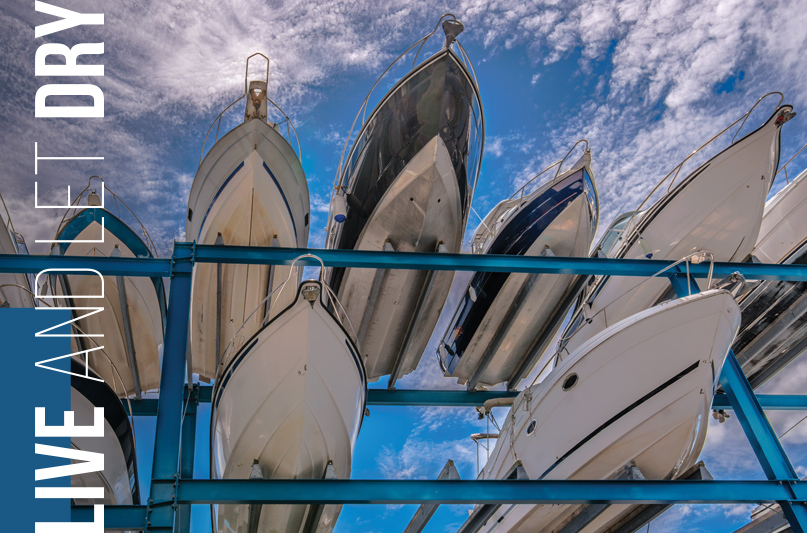
 Dry storage as a concept is less mandatory in the temperate coastal Pacific Northwest than most places throughout North America, but certainly attracts its fair share of boaters. Will the growth of dry stacking facilities and the urban squeezing of waterfront property change the game?
Dry storage as a concept is less mandatory in the temperate coastal Pacific Northwest than most places throughout North America, but certainly attracts its fair share of boaters. Will the growth of dry stacking facilities and the urban squeezing of waterfront property change the game?
Travel east over the Cascades or up and down the Atlantic seaboard, and you’ve probably seen quite a few of them; giant dry stacking facilities several rows tall, a wall of boat transoms like an army of defiant Scottish warriors lifting their kilts and giving you a collective mooning. While dry stacking, or dry storage in general, can be borderline mandatory in locations that freeze over, the temperate climate of the coastal Pacific Northwest makes the decision to dry stow your boat less black and white. One of the blessings that we shouldn’t take for granted is that we truly have year-round boating opportunities—as long as you layer up and keep the hot coffee and cocoa flowing, maybe with a skosh of brandy when tucked away for the night.
However, whether to put one’s boat into dry storage may be transforming in a larger industry question. Marina Dock Age published a nationwide facility operator survey in April 2018, and only one third of the respondents claimed that their facility was without dry storage of some kind. In the same report, facilities that were 10 years or newer reported a 1.4 percent increase in indoor dry storage (stacking) and 2.9 percent increase with covered dry storage (also stacking) than the overall average.
This steady increase in dry stacking combined with densely populated—and populating—waterfronts like Seattle may tease a shift toward the stacks. Seattle has increasingly less space to offer traditional wet storage options, the impending Chandler’s Cove development in South Lake Union just one prominent example. Even successful urban boatyards can’t afford to stow boats on the hard for extended periods of time the traditional jack stand way. Can space-efficient dry stacking offer a way forward for urban boaters?
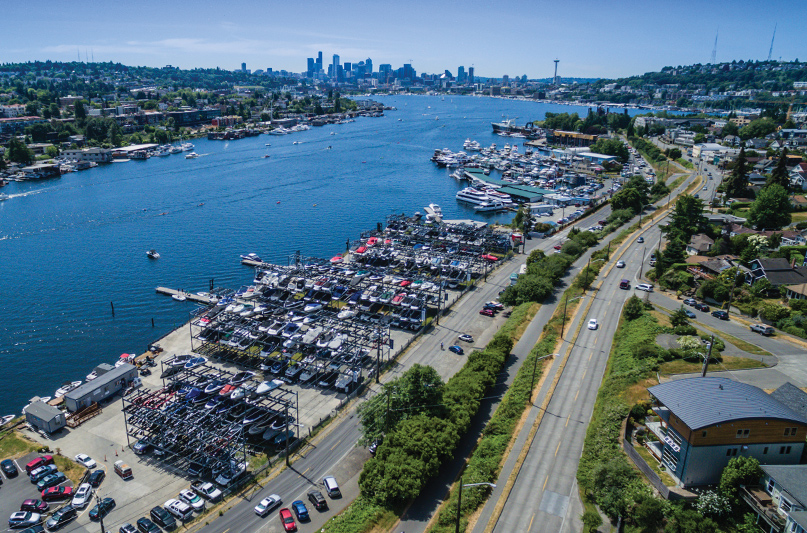
Firstly, it’s worth examining what exactly dry storage means and the various options on the table for boaters. The term dry storage is an umbrella term that contrasts with wet storage, which is any kind of long-term boat mooring situation where the boat in question remains in the water. Dry storage options include the aforementioned dry stacking, stands or blocks in a covered or open boatyard, and private solutions that include lifts and trailers.
For those lucky few of us with private property right on the water, it may be tempting to install a private boat lift for one’s own use. Commonly seen in Florida—where rampant bottom growth demands monthly or even weekly hull maintenance—or waters in places like the Midwest that freeze over; a private lift may be worth the investment in these areas. However, where many boating regions of the continent make this kind of investment a no-brainer, there are fewer seasonal threats to a boat in our waters, perhaps explaining why it’s less common to see boat lifts in the coastal Pacific Northwest.
Sam Basta of Basta Boatlifts has a few insights, “If your boat is exposed to wind, wake, or debris in the water it is worth getting a boat lift.” He continues, “Most of the lakes in the Northwest have fluctuating water levels. In addition to our broad range of lifting capacities, Basta Boatlifts offers products with vertical lifting ranges from 3′ to 6′. Our lifts are also very easy to adjust in the water column if you need to accommodate a larger lake fluctuation.”
An important element for private lifts is the cradle. The support of a boat on a private lift is a vital part of the equation, and most private lift vendors will take the trouble to send someone out to make the necessary measurements. Also essential when considering lifts are the weather conditions, for while the boat may be safer out of the water, the lift itself still needs to take the weather in stride. Heavy winds, heavy snows, and generally heavy weather can compromise a lift, and by proxy, the boat on the lift. We are blessed not to have a hurricane season in these parts, but if you’re on the Oregon coast and you go for a lift, make sure it’s a beefy one.
Size also matters, as most lift builders are clear about maximum tonnage and the length overall that they can serve.
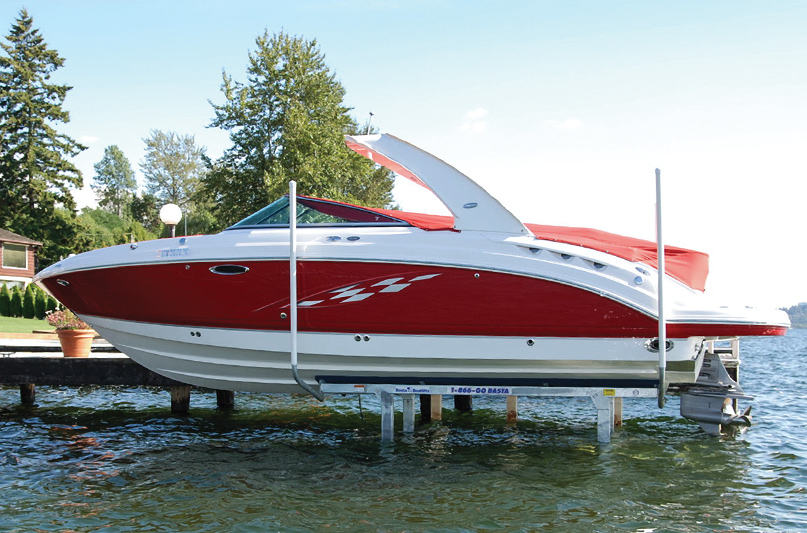
According to Basta, “The weight of your boat fully loaded with fuel and gear determines what lifting capacity you will need when selecting a boat lift. Other considerations are water depth and the slope and composition of the lake bottom. Basta Boatlifts has accessories such as hill stabilizers, extended legs, and bracing kits to accommodate the unique locations and requirements to make your boat lift secure.”
Trailers are worth a passing mention, but odds are that if you have a trailerable boat, you are familiar with the benefits. Check with your state’s regulations, but unless you’ve got special certifications and an oversized rig, the size of your trailerable boat will be limited.
Of course, the big plus to having your boat on your own lift or trailer is that you are firmly in control of the situation. If a crisp, clear, November weekend presents itself, why not sneak the boat in the water and head out? This level of flexibility is just not possible with the following options that involve a third party.
The classic term “on the hard” generally refers to the use of boat stands or blocks in a yard that support a boat. For many in the Pacific Northwest and beyond, a seasonal trip to the boatyard for needed maintenance involves some time on the boat stands. Whether you’re on the hard for as short a time as possible to get the to-do list done or want to leave the boat there for an extended time, the yard can beckon like a siren song.
As far as access to a boat is concerned, it doesn’t get much better than having the boat on a set of trusty jack stands. Wide open working space and hard-to-reach areas at eye level can make working on a boat as easy as it gets.
Of course, whether you can work on the boat yourself or not is up to the boatyard. In fact, the whole experience is up to the boatyard, which can either be great or horrific. Unlike the private lift or trailer option, you are very much at the mercy of a third party. Is the yard management friendly and flexible, or gruff and strict? This is the wildcard element to the dry storage in the boatyard experience, and it’s easy to see why boaters tend to find their favorite yard and stick with it year after year.
The benefits of stowing a boat on the hard are similar to the private lift or trailer option in that you’re keeping that hull in mint condition and have all the access you need to get that to-do list taken care of. One key element to pay attention to is the placement of the stands or blocks, which the yard workers should be well acquainted with.
For the Pacific Northwest, the yard is also where some boaters opt to shrink wrap their boats for the season. This method, which involves encasing the entire deck in a water- and airtight plastic wrap, is more typically seen in places with harsher winters than ours. However, wrapping is the ultimate anti-moisture method for those who are confident that they won’t be using their boat during the off-season. This method is also popular with boaters who keep their boats in the Pacific Northwest for summer cruising and are out of the state for extended periods of time during the winter.
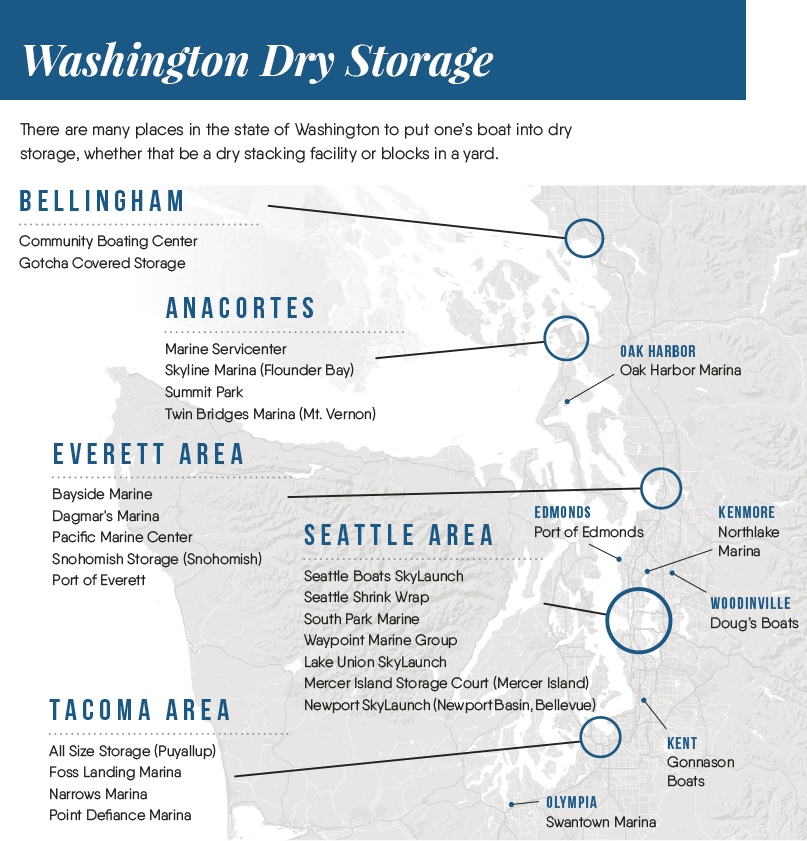
One economic limitation to keeping a boat on stands in a yard for extended periods of time is the limited space that most boatyards can allocate for this purpose. The typical yard manager is constantly juggling every square foot of yard for different kinds of paying customers, and often clients who are in and out with expensive jobs are more profitable than a fleet of low-maintenance boats in dry storage.
Ultimately, a boater who wants to do this may have to hunt around outside of major urban centers for the closest yard that embraces the long-term storage business model as part of their business. Nigel Barron, a manager at Seattle’s CSR Marine Solutions full service boatyard, weighs in.
“With the price of real estate in Seattle, storing boats out of the water is just not feasible. The only way it could potentially pencil out is with dry stack, because your footprint goes up, or if you are just really slow and are looking to fill the space,” says Barron. “We’ve done the math, and we just can’t afford to store boats. Figure a 40’ stall. I can, with little effort, turn 2.5 bottom jobs through that space in a month for $5,000. Would someone really pay $5,000 to store a 40’ boat for a month?”
Dry stacking as a concept is nothing new, with many lift manufacturers making affordable forklifts designed for boats since the 1970s. For savvy, space conscious boatyards, the idea of maximizing their available space by going vertical seemed worth a try. As the boat lifts improved, the number of boats that could be stacked grew. The Toyota Forklifts Blog published an article earlier this year touting their Toyota High-Capacity Marina Forklift, the design features of which includes a mast with a negative lift meant specifically for taking boats from the water and lifting them onto the stack. Clearly, even the largest manufacturers are responding to the demand for dry stacking.
“Dry stacking has been very popular for us and is in high demand,” says Trevor Campbell, the director of operations at the Seattle Boat Company’s Lake Union Skylaunch dry stacking facility. Seattle Boat Company manages three Skylaunch dry stacking facilities in the state. “Each year we have a lengthy waitlist of potential tenants that have realized the benefits of dry stack moorage.”
Dry stacking facilities are often climate controlled, meaning that your boat should get many of the same benefits as being wrapped without the expense. Speaking of affordability, dry stacking is generally cheaper than sitting on the stands for boat owners. This makes some intuitive economic sense, as the yard needs to charge less because of the efficient use of yard space.
But what of boat access? An owner will not have access to his or her boat in a dry stacking facility. However, most dry stacking facilities, with some heads up, will eagerly retrieve a client’s boat from the stack for those spontaneous off-season trips. Dry stacking is less of a commitment than a wrap, with many of the same benefits to protecting a boat.
“We use speedydock.com to allow our tenants to schedule boat movements including launch request and haul outs. Tenants can schedule a launch as soon as 30 minutes in advance,” says Campbell.
Dwight Jones, General Manager of Elliott Bay Marina, has some thoughts as a marina manager. “Dry stacking means less small boats in the water, which is good for keeping space open for bigger boats that have no other options,” he says.
“Small boats have lots of options with regards to moorage, so traditional marinas should gear more towards larger vessels. I think you will see less slips for small boats as marinas redevelop in the next 15 to 20 years.”
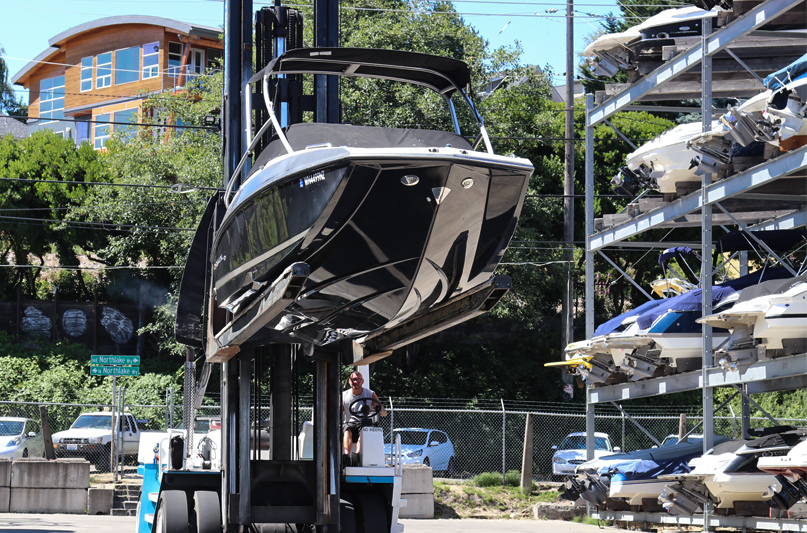
forklifts geared for the dry storage industry.
Another consideration is the potential benefit to the environment. “The more a boat stays out of the water, the less environmental impact from bottom paints and other pollutants it has,” says Aaron Barnett, the Boating Outreach Specialist with the nonprofit Washington Sea Grant.
This makes sense, for if a boat is only in the water for a limited amount of time there is much less time for the boat to leach chemicals, use and discharge wayward electricity, wear away systems like automated bilge pumps, etc. With the copper paint and marina electrical usage regulation sagas unfolding, perhaps part of the solution is just to take boats out of the water when possible.
Barnett continues, citing a scientific paper published in the Ecological Society of America by University of Washington scientists. “Most sloughing bottom paints, when in the water, will continually emit toxins such as copper which is known to affect salmon’s ability to smell and/or its natural alarm system that can leave salmon such as coho salmon vulnerable to predators. When a boat is kept out of the water when it’s not being used, it is obviously a reduction in toxins entering aquatic environments.”
Of course, dry stacking as we know it has limitations. Sailboats are largely out of the picture, their awkward fixed keel shapes and towering masts are difficult puzzle pieces for a dry stacking facility to accommodate. Also, heavy trawlers or yachts that are common in these waters are still out of the realm of possibility for most Pacific Northwest dry stacking facilities at the time of this writing. The facilities are also hard to permit.
“I really do not see it as competition. Dry stacking is really just another product for the consumer to choose,” says Jones, but he is wary of the future. “The real threat to traditional marinas is dry storage of large yachts like in Anacortes. It’s too early to tell what the long-term affect will be since the economy has been good and population growth in the region has been on a record pace. My fear is that a declining economy will force people to use their boats less and spend less on moorage which steers them to land. The storage lots in Anacortes take advantage of cheap land away from the water and are easy to permit and have very low operating costs… scary.”
“With waterfront real estate at a premium in Seattle, the only way to accommodate for the demand of moorage is to go up,” says Campbell.
“I don’t see any competition between dry stack and boat yards, or dry stack and wet slips,” says CSR’s Nigel Barron. “They’re just different animals. You’re not really going to dry stack your Grand Banks. That being said, the farther you get from King and Pierce County, the cheaper and easier it gets to make those numbers pencil out for long-term dry storage in a yard.”
Whether or not dry stacking takes center stage as the go-to moorage option for urban or big boat owners is unknown. Wherever land is valuable enough, the dry stacking facility model will generally out-compete other dry storage options, and wherever the land is cheap enough, dry stacking facilities are accommodating larger boats. Regardless, boaters in the Pacific Northwest are spoiled for storage options. At the end of the day, even the concept of dry storage is an option, for you can always leave your boat in the slip if that’s what’s best for you.
Read the full story on Issuu


